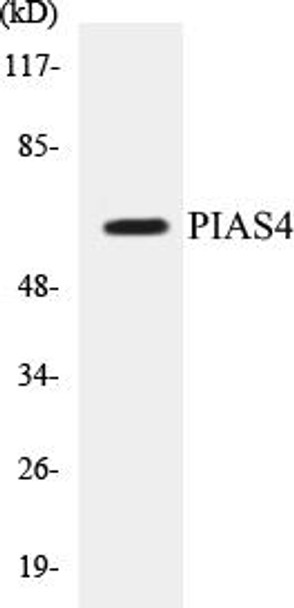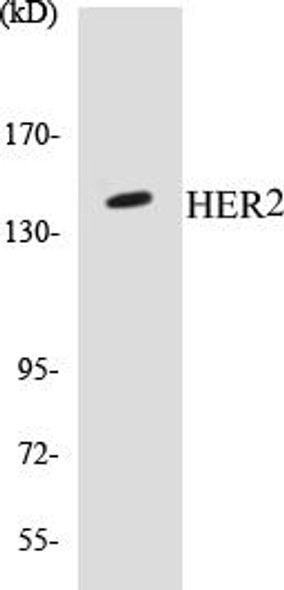PIAS4 Colorimetric Cell-Based ELISA Kit (CBCAB00814)
- SKU:
- CBCAB00814
- Product Type:
- ELISA Kit
- ELISA Type:
- Cell Based
- Research Area:
- Epigenetics and Nuclear Signaling
- Reactivity:
- Human
- Mouse
- Detection Method:
- Colorimetric
Description
PIAS4 Colorimetric Cell-Based ELISA Kit
The PIAS4 Colorimetric Cell-Based ELISA Kit is specifically designed to accurately detect and quantify levels of PIAS4 (Protein Inhibitor of Activated STAT 4) in cell lysates and tissue homogenates. This kit offers high sensitivity and specificity, allowing for reliable and reproducible results for a variety of research applications.PIAS4 is a key regulator of the STAT signaling pathway, playing a critical role in modulating cellular processes such as inflammation, immune response, and cell proliferation. Dysregulation of PIAS4 has been implicated in various diseases, including cancer, autoimmune disorders, and inflammatory conditions, making it a valuable biomarker for studying these pathological processes and developing novel therapeutic strategies.
With the PIAS4 Colorimetric Cell-Based ELISA Kit, researchers can confidently measure PIAS4 levels in biological samples, providing valuable insights into the underlying mechanisms of disease and potential targets for intervention. Order now to accelerate your research and uncover new insights into PIAS4 biology.
| Product Name: | PIAS4 Colorimetric Cell-Based ELISA Kit |
| Product Code: | CBCAB00814 |
| ELISA Type: | Cell-Based |
| Target: | PIAS4 |
| Reactivity: | Human, Mouse |
| Dynamic Range: | > 5000 Cells |
| Detection Method: | Colorimetric 450 nmStorage/Stability:4°C/6 Months |
| Format: | 96-Well Microplate |
The PIAS4 Colorimetric Cell-Based ELISA Kit is a convenient, lysate-free, high throughput and sensitive assay kit that can detect PIAS4 protein expression profile in cells. The kit can be used for measuring the relative amounts of PIAS4 in cultured cells as well as screening for the effects that various treatments, inhibitors (ie siRNA or chemicals), or activators have on PIAS4.
Qualitative determination of PIAS4 concentration is achieved by an indirect ELISA format. In essence, PIAS4 is captured by PIAS4-specific primary antibodies while the HRP-conjugated secondary antibodies bind the Fc region of the primary antibody. Through this binding, the HRP enzyme conjugated to the secondary antibody can catalyze a colorimetric reaction upon substrate addition. Due to the qualitative nature of the Cell-Based ELISA, multiple normalization methods are needed:
| 1. | A monoclonal antibody specific for human GAPDH is included to serve as an internal positive control in normalizing the target absorbance values. |
| 2. | Following the colorimetric measurement of HRP activity via substrate addition, the Crystal Violet whole-cell staining method may be used to determine cell density. After staining, the results can be analysed by normalizing the absorbance values to cell amounts, by which the plating difference can be adjusted. |
| Database Information: | Gene ID: 51588, UniProt ID: Q8N2W9, OMIM: 605989, Unigene: Hs.105779 |
| Gene Symbol: | PIAS4 |
| Sub Type: | None |
| UniProt Protein Function: | PIAS4: Functions as an E3-type small ubiquitin-like modifier (SUMO) ligase, stabilizing the interaction between UBE2I and the substrate, and as a SUMO-tethering factor. Plays a crucial role as a transcriptional coregulation in various cellular pathways, including the STAT pathway, the p53 pathway, the Wnt pathway and the steroid hormone signaling pathway. Involved in gene silencing. Promotes PARK7 sumoylation. In Wnt signaling, represses LEF1 and enhances TCF4 transcriptional activities through promoting their sumoylations. Interacts with AR, AXIN1, GATA2, LEF1, TP53 and STAT1 (IFNG-induced). Binds to AT-rich DNA sequences, known as matrix or scaffold attachment regions (MARs/SARs). Interacts with TICAM1. Interacts with KLF8; the interaction results in SUMO ligation and repression of KLF8 transcriptional activity and of its cell cycle progression into G(1) phase. Highly expressed in testis and, at lower levels, in spleen, prostate, ovary, colon and peripheral blood leukocytes. Belongs to the PIAS family. |
| UniProt Protein Details: | Protein type:SUMO conjugating system; Transcription, coactivator/corepressor; EC 6.3.2.-; Nuclear receptor co-regulator Chromosomal Location of Human Ortholog: 19p13.3 Cellular Component: cytoplasm; nucleoplasm; nucleus Molecular Function:protein binding; SUMO ligase activity; ubiquitin protein ligase binding Biological Process: double-strand break repair via nonhomologous end joining; negative regulation of transcription, DNA-dependent; positive regulation of protein sumoylation; protein sumoylation |
| UniProt Code: | Q8N2W9 |
| NCBI GenInfo Identifier: | 34922831 |
| NCBI Gene ID: | 51588 |
| NCBI Accession: | Q8N2W9.1 |
| UniProt Secondary Accession: | Q8N2W9,O75926, Q96G19, Q9UN16, |
| UniProt Related Accession: | Q8N2W9 |
| Molecular Weight: | 56,504 Da |
| NCBI Full Name: | E3 SUMO-protein ligase PIAS4 |
| NCBI Synonym Full Names: | protein inhibitor of activated STAT 4 |
| NCBI Official Symbol: | PIAS4 |
| NCBI Official Synonym Symbols: | PIASY; Piasg; ZMIZ6; PIAS-gamma |
| NCBI Protein Information: | E3 SUMO-protein ligase PIAS4 |
| UniProt Protein Name: | E3 SUMO-protein ligase PIAS4 |
| UniProt Synonym Protein Names: | PIASy; Protein inhibitor of activated STAT protein 4; Protein inhibitor of activated STAT protein gamma; PIAS-gamma |
| Protein Family: | E3 SUMO-protein ligase |
| UniProt Gene Name: | PIAS4 |
| UniProt Entry Name: | PIAS4_HUMAN |
| Component | Quantity |
| 96-Well Cell Culture Clear-Bottom Microplate | 2 plates |
| 10X TBS | 24 mL |
| Quenching Buffer | 24 mL |
| Blocking Buffer | 50 mL |
| 15X Wash Buffer | 50 mL |
| Primary Antibody Diluent | 12 mL |
| 100x Anti-Phospho Target Antibody | 60 µL |
| 100x Anti-Target Antibody | 60 µL |
| Anti-GAPDH Antibody | 60 µL |
| HRP-Conjugated Anti-Rabbit IgG Antibody | 12 mL |
| HRP-Conjugated Anti-Mouse IgG Antibody | 12 mL |
| SDS Solution | 12 mL |
| Stop Solution | 24 mL |
| Ready-to-Use Substrate | 12 mL |
| Crystal Violet Solution | 12 mL |
| Adhesive Plate Seals | 2 seals |
The following materials and/or equipment are NOT provided in this kit but are necessary to successfully conduct the experiment:
- Microplate reader able to measure absorbance at 450 nm and/or 595 nm for Crystal Violet Cell Staining (Optional)
- Micropipettes with capability of measuring volumes ranging from 1 µL to 1 ml
- 37% formaldehyde (Sigma Cat# F-8775) or formaldehyde from other sources
- Squirt bottle, manifold dispenser, multichannel pipette reservoir or automated microplate washer
- Graph paper or computer software capable of generating or displaying logarithmic functions
- Absorbent papers or vacuum aspirator
- Test tubes or microfuge tubes capable of storing ≥1 ml
- Poly-L-Lysine (Sigma Cat# P4832 for suspension cells)
- Orbital shaker (optional)
- Deionized or sterile water
*Note: Protocols are specific to each batch/lot. For the correct instructions please follow the protocol included in your kit.
| Step | Procedure |
| 1. | Seed 200 µL of 20,000 adherent cells in culture medium in each well of a 96-well plate. The plates included in the kit are sterile and treated for cell culture. For suspension cells and loosely attached cells, coat the plates with 100 µL of 10 µg/ml Poly-L-Lysine (not included) to each well of a 96-well plate for 30 minutes at 37°C prior to adding cells. |
| 2. | Incubate the cells for overnight at 37°C, 5% CO2. |
| 3. | Treat the cells as desired. |
| 4. | Remove the cell culture medium and rinse with 200 µL of 1x TBS, twice. |
| 5. | Fix the cells by incubating with 100 µL of Fixing Solution for 20 minutes at room temperature. The 4% formaldehyde is used for adherent cells and 8% formaldehyde is used for suspension cells and loosely attached cells. |
| 6. | Remove the Fixing Solution and wash the plate 3 times with 200 µL 1x Wash Buffer for five minutes each time with gentle shaking on the orbital shaker. The plate can be stored at 4°C for a week. |
| 7. | Add 100 µL of Quenching Buffer and incubate for 20 minutes at room temperature. |
| 8. | Wash the plate 3 times with 1x Wash Buffer for 5 minutes each time. |
| 9. | Add 200 µL of Blocking Buffer and incubate for 1 hour at room temperature. |
| 10. | Wash 3 times with 200 µL of 1x Wash Buffer for 5 minutes each time. |
| 11. | Add 50 µL of 1x primary antibodies (Anti-PIAS4 Antibody and/or Anti-GAPDH Antibody) to the corresponding wells, cover with Parafilm and incubate for 16 hours (overnight) at 4°C. If the target expression is known to be high, incubate for 2 hours at room temperature. |
| 12. | Wash 3 times with 200 µL of 1x Wash Buffer for 5 minutes each time. |
| 13. | Add 50 µL of 1x secondary antibodies (HRP-Conjugated AntiRabbit IgG Antibody or HRP-Conjugated Anti-Mouse IgG Antibody) to corresponding wells and incubate for 1.5 hours at room temperature. |
| 14. | Wash 3 times with 200 µL of 1x Wash Buffer for 5 minutes each time. |
| 15. | Add 50 µL of Ready-to-Use Substrate to each well and incubate for 30 minutes at room temperature in the dark. |
| 16. | Add 50 µL of Stop Solution to each well and read OD at 450 nm immediately using the microplate reader. |
(Additional Crystal Violet staining may be performed if desired – details of this may be found in the kit technical manual.)






